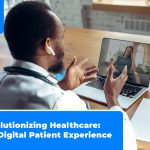Patient experience is becoming increasingly important in the healthcare industry. Patients are now more informed and empowered than ever thus, they expect a high level of care and service.
Healthcare organizations providing a positive patient experience will gain a competitive advantage. According to Deloitte research, hospitals with improved patient experience perform better financially. The research also found that nurse-patient engagement – how nurses interface with patients, has a profound impact on providing better care.
Why does patient experience matter for both patients and healthcare providers?
For patients, a positive experience can lead to increased trust in their care team, better adherence to treatment plans, and improved well-being. On the other hand, healthcare providers benefit from higher patient satisfaction scores, stronger patient-provider relationships, increased patient retention, and ultimately, a more successful practice.
In this blog, we’ll delve into the world of patient experience, exploring its importance and strategies for enhancing patient experience. We’ll also cover how to evaluate patient experience systems and how you can overcome common challenges with patient experience.
Understanding Patient Experience
Patient experience encompasses all interactions that patients have with healthcare providers, from the moment they step into a facility to the follow-up care they receive after treatment. It goes beyond just the clinical aspects of care, taking into account factors such as communication, empathy, and the overall environment. The quality of these experiences can significantly impact patient satisfaction, health outcomes, and even the reputation of healthcare providers.
Patient experiences can be broken down into two main categories: physical and digital. Physical experiences are those that occur in person, such as the way patients are greeted and treated by the staff, the cleanliness and comfort of the facility, and the overall level of care they receive. Digital experiences are those that occur online or through mobile devices, such as the ability to access patient records, schedule appointments, and communicate with providers.
Both physical and digital experiences are important to patient satisfaction. According to this study on the impact of a hospital’s physical environment, the physical environment of a healthcare facility can reduce patient stress and improve outcomes. The study also reported an increase in staff effectiveness in delivering care.
The Impact of Positive Patient Experience
A positive patient experience has a tangible impact on various aspects of healthcare, which include:
Improved Patient Satisfaction
When patients have a positive experience, they are more likely to be satisfied with their care and remain loyal to the healthcare provider. This can lead to increased patient retention and referrals.
Better Health Outcomes
A positive patient experience can contribute to better health outcomes by fostering trust and open communication between patients and healthcare providers. This, in turn, encourages patients to follow treatment plans more closely, resulting in improved health outcomes.
According to recent results from The Beryl Insitute – Ipsos PX Pulse, half (51%) of Americans surveyed believes a good patient experience contributes to their healing.
Reduced Healthcare Costs
A positive patient experience enables healthcare providers to identify areas for improvement, streamline processes, and reduce inefficiencies. This can lead to lower operational costs, decreased readmission rates, and reduced costs for healthcare organizations.
Strategies for Enhancing Patient Experience
A creative strategy is crucial in ensuring a seamless, positive experience for patients. Let’s dive into the different approaches that can help improve patient experience
Communication
Effective communication is fundamental to a positive patient experience. You can improve communication and information sharing by
- Encouraging open communication and active listening in interactions between healthcare providers and patients.
- Providing clear and comprehensive information about diagnoses, treatment options, and potential side effects.
- Leveraging tools like patient portals, secure messaging, and telehealth to facilitate communication and information sharing.
Empathy and Compassion
Creating an empathetic and compassionate environment is vital for fostering trust and satisfaction. You can do this by
- Cultivating a compassionate healthcare environment that encourages staff to treat patients with kindness, respect, and understanding.
- Offering workshops and training sessions to help carers develop and refine their empathetic communication skills.
- Recognizing and responding to patients’ emotional concerns and providing appropriate support.
Accessibility and Convenience
Ensuring that care is accessible and convenient can greatly enhance the patient experience. You can create accessible healthcare by
- Implementing efficient scheduling systems and minimizing wait times for appointments
- Enhancing accessibility for diverse patient populations such as language translation services and accommodating patients with disabilities or special needs such as braille signage in high-traffic areas like entrances and waiting rooms.
- Creating a comfortable, welcoming environment with amenities like ample seating, and clean and accessible restrooms.
- Providing physical accessibility such as wheelchair-accessible ramps and elevators, and accessible parking. You can also provide patients with tools that guide them to the right physical spaces, such as maps and wayfinding signs.
Shared Decision-Making
Involving patients in their care can also lead to better outcomes and higher satisfaction. You can encourage shared decision-making through these methods:
- Actively engaging patients in discussions about their treatment options and preferences.
- Providing educational resources and tools to help patients make informed decisions.
- Collaborating with patients to set realistic and achievable health goals.
Continuity of Care
Ensuring continuity of care is essential for a positive patient experience. You can deliver a seamless experience through:
- Coordinated care across different facilities such as primary care providers, specialists, and other healthcare professionals.
- Effective transitions through healthcare settings and proper care handoffs
- Personalized care plans that address each patient’s unique needs and preferences.
Technology plays an instrumental role in enabling this continuity of care. Electronic health records (EHRs), telemedicine platforms, and mobile applications facilitate real-time information sharing between healthcare providers, reducing the chances of fragmented or uncoordinated care. Furthermore, these digital solutions enable remote monitoring and virtual consultations, making it easier for patients to stay connected with their healthcare team and receive ongoing support.
Patient Feedback and Engagement
Actively involving patients in their care and seeking their feedback can lead to valuable insights and improvements. You can do this by
- Collecting regular feedback through surveys, focus groups, or informal conversations.
- Inviting patients to participate in committees or advisory councils focused on enhancing care and patient experience.
- Leveraging patient support groups where patients share experiences and learn from one another.
Overcoming Challenges in Improving Patient Experience
Improving patient experience involves coordinating various aspects of care delivery which can often come with many challenges. Some of the prominent challenges include:
Resource Constraints
Healthcare organizations are often under-resourced, which can make it challenging to provide a high-quality patient experience. One way to work within resource constraints is to focus on the most important areas for improvement. For example, if a hospital is short-staffed and wants to improve wait times in the emergency room they could leverage technology to automate manual tasks such as check-in or accessing medical records.
Resistance to Change
When healthcare providers try to improve the patient experience, they often have to manage staff who are reluctant to adapt to the new ways. You can address this resistance by involving staff members in the planning process. When staff feel like they have a say in how things will change, they are more likely to be supportive of the change.
Cultural and Language Barriers
Healthcare organizations often face some challenges when handling patients from different cultural backgrounds. You can overcome these cultural and language barriers by hiring interpreters. Additionally, you can train staff on cultural competency as this will help them to understand the different cultures of their patients.
Measuring and Evaluating Patient Experience
Evaluating patient experience is essential for identifying areas for improvement. It also helps to ensure that healthcare providers are meeting patients’ needs and expectations. By regularly assessing patient experience, organizations can make data-driven decisions, track progress, and show their commitment to providing high-quality care.
Common metrics such as patient safety, wait time, bedside manner, and patient satisfaction surveys are handy measurement tools to evaluate patients’ experiences. Additionally, you can use The Hospital Consumer Assessment of Healthcare Providers and Systems (HCAHPS) survey to get a full picture of patients’ experiences if your healthcare organization is eligible to participate in the HCAHPS in the data collection and reporting involved.
Technology can also play an important role in capturing patient feedback. There are many technologies available today that you can use, such as patient portals, text messaging, and social media which often incorporate analytics that enable you to evaluate how patients are perceiving the care they receive from your facility.
You can use one or a combination of these tools to get feedback from patients and engage them in discussions about their experiences.
The data collected from patient experience surveys must be used toward improving healthcare over time. For example, if the data shows that patients are not satisfied with how their pain is managed, the healthcare organization can take steps to improve its pain management techniques.
Case Studies: Successful Patient Experience Initiatives
Virginia Hospital Center
An interesting case study of a successful patient experience initiative is how Virginia Hospital Center (VHC) improved its patient experience with a cohesive mobile app that focused on enhancing patients’ convenience and care.
VHC leveraged Phunware’s tech such as blue dot SDK, GPS, and more to provide patients, visitors, and staff with access to interactive maps that direct them to their location in real-time as well as enable patients to manage their appointments through remote telehealth.
Dignity Health
Another outstanding case study is how Dignity Health fulfilled the unique patient experience needs of its healthcare facilities across 39 sites.
Dignity Health leveraged Phunware’s tech to provide patients and visitors with solutions such as smooth routing throughout healthcare facilities across multiple floors. Patients can confidently navigate the facilities and access physicians and departments seamlessly.
The solution also benefited staff and administrators. They can further improve the patient experience with insights from the native analytics and business intelligence.
The Future of Patient Experience
The development and application of technology in healthcare is creating a new landscape for healthcare professionals. From increased access to medical data to sophisticated predictive analytics and artificial intelligence, these advancements enable healthcare organizations to prioritize improving the patient experience.
These technologies allow providers to shift from traditional, reactive care models to a proactive patient-centered model, with proactive health management, remote patient monitoring, and health notifications being just some of the applications.
Along with greater access to healthcare technologies, patient experience is also becoming an integral part of healthcare policy and reimbursement models. This shift from traditional cost-based reimbursements to value-based models will reward healthcare providers for delivering better patient outcomes. With patient experience becoming a factor for reimbursement, healthcare providers will be motivated to provide an improved service.
The integration of patient experience into healthcare policies is just the beginning of providing better care. Many healthcare organizations are exploring ways to use data to better understand patient needs and create tailored services. Additionally, with the rise of telemedicine, virtual reality, artificial intelligence, and robotics, it is foreseeable that digital health will become an invaluable complement to care.
Finally, healthcare systems worldwide are beginning to embrace patient-centered wellness, providing access to mental health services, nutrition plans, and lifestyle coaching to keep their patients healthy, active, and thriving.
Conclusion
The importance of patient experience is evident from its potential to deliver better health outcomes, improve patient satisfaction, and reduce healthcare costs. To maximize the potential of patient experience, healthcare organizations must utilize vital strategies like effective communication and information sharing, show empathy and compassion, provide convenient healthcare services, and many more.
It’s also essential to evaluate your patient experience strategies using different metrics to ensure effectiveness.
By now, you know why healthcare organizations need to prioritize patient experience. This prioritization will enable them to provide better care throughout the patient journey, increase patient loyalty, and unlock internal efficiencies that save valuable time and money.
If you’re looking to empower patients and enhance the care your healthcare organization delivers, Phunware provides cutting-edge tech that boosts patient engagement and improves operational efficiency.







